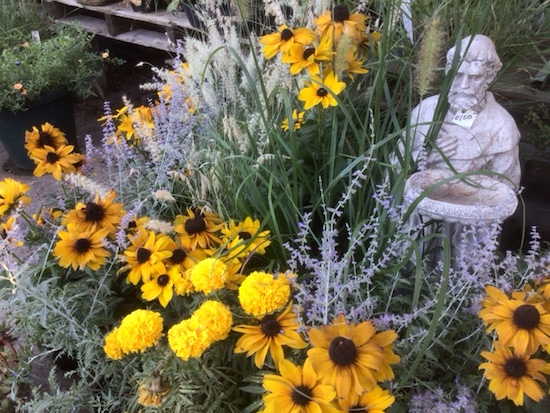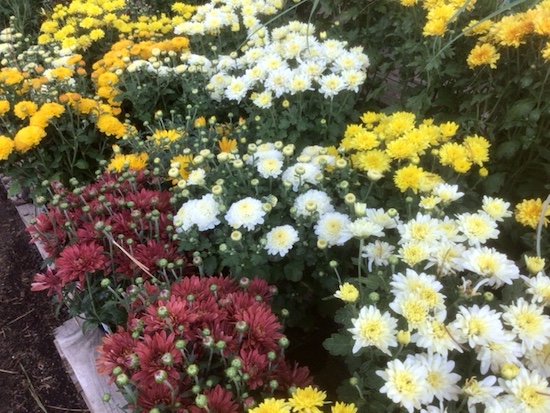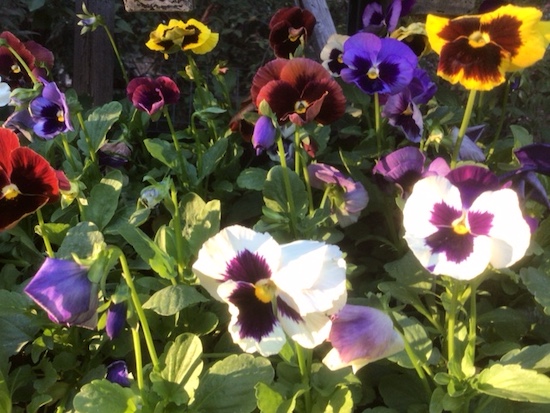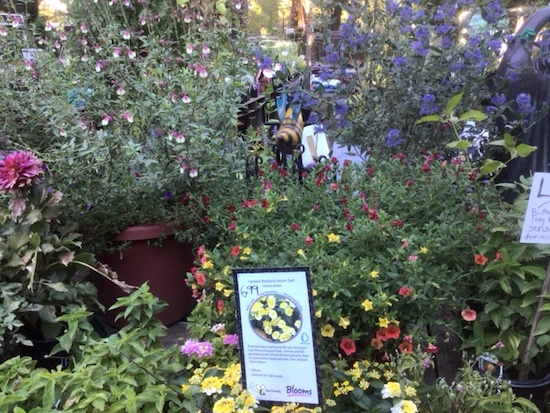
Notice: Open 10-2 Labor Day.
Labor Day weekend is upon us, and it looks like our weather will be roasting. UGH! I was hoping for cooler weather as my tomatoes do so much better in the Fall. Besides the heat causing the pollen to be non-viable (see last month’s newsletter for more on that), all the bees are over at the nursery. Next year I am definitely going to have to plant some pollinator-attracting flowers next to my vegetables. All in all, though, believe it or not, the summer so far has not been as hot as some. Lots of days in the 90’s instead of the 100s.
Hot enough, and every year the sun gets more intense as our atmosphere thins.
Bright spots are happening even though it does not feel like it. One of my latest Ag Alert newspapers was about more farms, especially organic ones, turning to no-till, hedgerows, and cover-cropping. If I remember right, they stated there are only 14 inches of topsoil left in CA. If you have ever driven by a field when it was being disced or plowed, there is a tremendous amount of soil in the form of dust getting lost into the air. Lots of talk in the news about a mega-flood, but we are in some serious drought conditions, and cover-cropping and mowing is helping orchards retain moisture in the ground. We also know that soil high in organic matter is more moisture retentive. That will help during the rainy season with less runoff and more recharging of the groundwater system. Considering how our rain came last year, mostly in two separate events, one being over 10 inches in just a few days, a mega-flood is not a stretch even in our worsening drought. It might be worth looking at where your roof, driveway, and other non-permeable surfaces drain to and try to keep that precious water from going into the ocean. After all, there is plenty of evidence the sea level is rising without your water adding to it.

Do you talk to your plants? I read about a survey where out of 1,250 folks, 48% said yes. 20% off those people who talk to their plants every day. Some even kiss their plants. Most plant talkers believe it helps them grow. 80% of plant talkers are speaking to their houseplants, but tree talkers come in at 37%. Maybe the difference has something to do with not having the neighbors see you talking to your plants and thinking you are crazy. That brings me to the last bit. 62% of plant talkers say it helps their own mental health. Talk on!
German Iris bulbs are traditionally the first to arrive, and we have four colors to choose from: light purple, pink, yellow, and orange. We are expecting a shipment of onion bulbs next week and garlic the week after. About mid-month, the daffodils and tulips will be arriving with a few others, like paperwhites and amaryllis, for the holidays coming in October. Typically we can not get potatoes until November.
It is definitely time to think about the fall garden. Starts are available now of peas, beets, broccoli, kale, cabbage, and more. Lots of great seeds to choose from too. Although this hot Labor Day weekend is probably not the time to plant, you can start preparing the soil for them. Remember that vegetables deplete the soil rapidly, and you will have to add organic matter in the form of GreenAll Soil Booster, chicken and/or steer manure, earthworm castings, and granular amendments if you want them to thrive. The earlier you plant, the bigger your harvest will be in the cold months ahead. Late planting usually means no harvest until early spring. A long maturing crop like Brussels Sprouts needs over 100 days and needs to go in ASAP.

Petunias are on their way out, and pansies and violas are on their way in and available now. Plenty of Fall Garden Mums in stock too. Fall is also Aster time, and we have them. Other late blooming perennials include
Dwarf Plumbago, Japanese Anemones, Bluebeard, Autumn Sage, and Autumn Joy Sedum. Add to that your long-blooming Russian Sage, Hummingbird Mint, Blanket Flower, Coreopsis, Coneflowers, and Black-eyed Susans, and there is no reason for you not to have plenty of color/pollinator food this time of year.
I think I mentioned feeding your citrus and acid-loving plants, including blueberries, last month, but I will say so again. By acid-loving, I am talking mostly about shade shrubs like Azaleas, Gardenias, Rhodies, Hydrangeas, and Camellias. Use EBS Camellia/Gardenia food available here in 4# and 15# bags. Organic, of course. If the new leaves are yellow but the veins are green you need to feed it some iron. We like the GreenAll FST for this, but we have liquid iron too. If you have not fed your roses and other blooming plants lately this is the month to do so. Feeding now will give them the energy to keep flowering, and they will not start out the spring completely depleted. Organic and other solid fertilizer takes time to break down in the soil to a form the plants can use (unless we are talking about worm castings).

It is beneficial to give your fruit trees a feeding early this month with a complete fertilizer. Complete means it has all three major nutrients NPK. Those are the 3 numbers on the front of the label. Nitrogen for green growth, phosphorous for rooting and flowering and potassium for disease resistance, and a strong vascular system. Next month you can give them some 0-10-10 for spring flowering along with other spring blooming shrubs like Lilacs, Wisteria, Spireas, Viburnums, Quince, and Forsythia.
If you have been staying away through the toughest time to plant here, we hope to see you soon. We have plenty to choose from. The mantra is: Fall is the best time to plant, Fall is the best time to plant, Fall is the best time to plant.
September Specials
20% OFF
- EBS Organic Citrus and Fruit Fertilizer
- EBS Organic Fruit, Berry and Vine
- Japanese Maples in stock
- Succulents
- Roses in stock
- Daylilies in stock

Save the date:
Sept 24 and 25: Customer Appreciation Days
Storewide specials and more!
Oct 8: Closing at 2 for a staff event